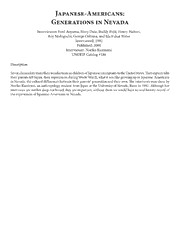
Japanese-Americans Generations in Nevada: Oral History Interviews with Fred Aoyama, Mary Date, Buddy Fujii, Henry Hattori, Roy Nishiguchi, George Oshima, and Ida Fukui Weiss PDF
Preview Japanese-Americans Generations in Nevada: Oral History Interviews with Fred Aoyama, Mary Date, Buddy Fujii, Henry Hattori, Roy Nishiguchi, George Oshima, and Ida Fukui Weiss
Japanese-Americans: Generations in Nevada Interviewees: Fred Aoyama, Mary Date, Buddy Fujii, Henry Hattori, Roy Nishiguchi, George Oshima, and Ida Fukui Weiss Interviewed: 1992 Published: 2000 Interviewer: Noriko Kunitomi UNOHP Catalog #186 Description Seven chroniclers share their recollections as children of Japanese immigrants to the United States. Th ey explore why their parents left Japan, their experiences during World War II, what it was like growing up as Japanese-Americans in Nevada, the cultural diff erences between their parents’ generation and their own. Th e interviews were done by Noriko Kunitomi, an anthropology student from Japan at the University of Nevada, Reno in 1992. Although her interviews are neither deep nor broad, they are important; without them we would have no oral history record of the experiences of Japanese-Americans in Nevada. Japanese-Americans Generations in Nevada Japanese-Americans Generations in Nevada Oral History Interviews with Fred Aoyama, Mary Date, Buddy Fujii, Henry Hattori, Roy Nishiguchi, George Oshima and Ida Fukui Weiss An Oral History Conducted by Noriko Kunitomi Edited by Kathleen M. Coles and Susan Imswiler University of Nevada Oral History Program Copyright 2000 University of Nevada Oral History Program Mail Stop 0324 Reno, Nevada 89557 [email protected] http://www.unr.edu/oralhistory All rights reserved. Published 2000. Printed in the United States of America Publication Staff : Director: R. T. King Assistant Director: Mary Larson Production Manager: Kathleen M. Coles Text Designer: Linda Sommer Production Assistants: Amy Fiack, Verne W. Foster University of Nevada Oral History Program Use Policy All UNOHP interviews are copyrighted materials. Th ey may be downloaded and/or printed for personal reference and educational use, but not republished or sold. Under “fair use” standards, excerpts of up to 1000 words may be quoted for publication without UNOHP permission as long as the use is non-commercial and materials are properly cited. Th e citation should include the title of the work, the name of the person or people interviewed, the date of publication or production, and the fact that the work was published or produced by the University of Nevada Oral History Program (and collaborating institutions, when applicable). Requests for permission to quote for other publication, or to use any photos found within the transcripts, should be addressed to the UNOHP, Mail Stop 0324, University of Nevada, Reno, Reno, NV 89557-0324. Original recordings of most UNOHP interviews are available for research purposes upon request. Contents Preface to the Digital Edition ix Original Preface xi 1. Fred Aoyama 1 2. Mary Date 19 3. Buddy Fujii 31 4. Henry Hattori 47 5. Roy Nishiguchi 61 6. George Oshima 83 7. Ida Fukui Weiss 93 Original Index: For Reference Only 103 Preface to the Digital Edition Established in 1964, the University of While taking great pains not to alter Nevada Oral History Program (UNOHP) meaning in any way, the editor may have explores the remembered past through removed false starts, redundancies, and the rigorous oral history interviewing, creating a “uhs,” “ahs,” and other noises with which record for present and future researchers. Th e speech is oft en liberally sprinkled; compressed program’s collection of primary source oral some passages which, in unaltered form, histories is an important body of information misrepresent the chronicler’s meaning; and about significant events, people, places, relocated some material to place information and activities in twentieth and twenty-fi rst in its intended context. Laughter is represented century Nevada and the West. with [laughter] at the end of a sentence in The UNOHP wishes to make the which it occurs, and ellipses are used to information in its oral histories accessible indicate that a statement has been interrupted to a broad range of patrons. To achieve or is incomplete…or that there is a pause for this goal, its transcripts must speak with dramatic eff ect. an intelligible voice. However, no type font As with all of our oral histories, while contains symbols for physical gestures and we can vouch for the authenticity of the vocal modulations which are integral parts interviews in the UNOHP collection, we of verbal communication. When human advise readers to keep in mind that these are speech is represented in print, stripped of remembered pasts, and we do not claim that these signals, the result can be a morass of the recollections are entirely free of error. seemingly tangled syntax and incomplete We can state, however, that the transcripts sentences—totally verbatim transcripts accurately refl ect the oral history recordings sometimes verge on incoherence. Th erefore, on which they were based. Accordingly, each this transcript has been lightly edited. transcript should be approached with the x Japanese-Americans: Generations in Nevada same prudence that the intelligent reader exercises when consulting government records, newspaper accounts, diaries, and other sources of historical information. All statements made here constitute the remembrance or opinions of the individuals who were interviewed, and not the opinions of the UNOHP. In order to standardize the design of all UNOHP transcripts for the online database, most have been reformatted, a process that was completed in 2012. Th is document may therefore diff er in appearance and pagination from earlier printed versions. Rather than compile entirely new indexes for each volume, the UNOHP has made each transcript fully searchable electronically. If a previous version of this volume existed, its original index has been appended to this document for reference only. A link to the entire catalog can be found online at http://oralhistory.unr.edu/. For more information on the UNOHP or any of its publications, please contact the University of Nevada Oral History Program at Mail Stop 0324, University of Nevada, Reno, NV, 89557-0324 or by calling 775/784-6932. Alicia Barber Director, UNOHP July 2012
